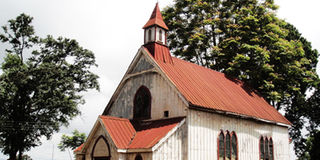In this church compound lies a ‘greater soul’ than Blixen’s

PHOTO | JOHN FOX
A few weeks ago, in a piece about Karen Blixen and her lover’s grave, I said I was thinking of doing a series of Going Places on Kenyan cemeteries. The idea seems to have aroused quite a bit of interest – judging by the number of encouraging emails that have come.
One of them was from someone called Isaac. He invited me to go to the Church of the Torch at Thogoto, where I would find the grave of Minnie Watson.
Her story, Isaac said, is ‘‘of a much greater soul than Karen Blixen’’, but one ‘‘without sex or scandal’’, so likely to be of less interest to the world.
I went. Glad of the suggestion. I lived near there once, in the late 1960s, teaching at the Adult Studies Centre of the University of Nairobi.
I have many good memories of how life was on those Kikuyu ridges: the bracing mists of the early mornings; the sightings of Kilimanjaro in the clear evenings; the drives down the winding road to the nightclubs of town; the friendships with my Kenyan colleagues; the debates with our students, who came from all parts of the country and some from elsewhere in Africa.
Schools have multiplied
So I knew well the strong contribution the neighbouring PCEA mission had made: the schools, the training centres, the hospital ... So it was good, the other day, to see how vibrant life is at Thogoto now: how the schools have multiplied; how the hospital has expanded ...
But I was very sad to see the dilapidated state of the original Church of the Torch – the paint peeling off the walls, the broken shutters, the many missing windows. Shouldn’t such historic buildings be preserved?
But the cemetery is very well cared for. And I did find the grave of Minnie Watson beside that of her husband.
It was Thomas Watson who had initiated the Thogoto mission in 1898 on land allocated to him by the son of Chief Waiyaki.
He was the only survivor of a group of six who came out from Britain to establish a mission station at Kibwezi seven years earlier, as part of the ambitious plan of the Church of Scotland to establish such stations right along the spine of Africa.
It was a time of famine, and thousands of Kikuyu died. Watson brought out his new wife, Minnie, and they provided what relief they could, appealing for special donations from Scotland.
Then Thomas himself fell ill and died – in the December of 1900. And so, only one year after her arrival, Minnie was left to carry on the work of the mission – which she did for another 49 years, until her own death at Thogoto.
As part of the mission’s centenary celebrations a rondavel, in the style of a traditional Kikuyu hut, was erected in Minnie’s honour, in the grounds of the new Church of the Torch that was founded in 1928.
Thomas Watson’s successor was Clement Scott who, believing that the mission should be self-supporting, bought 3,000 acres of land at
Thogoto as an agricultural estate. Scott was the first white man Jomo Kenyatta saw when he preached at his village in Muthiga.
And you will know that the young Jomo Kenyatta joined the Thogoto mission school in November 1909.
His arrival was like any other Kikuyu herds boy’s, as recorded in the mission journal and quoted in an excellent biography, Kenyatta, by Jeremy
Murray-Brown: ‘‘There the boy stood, probably 11 or 12 years of age, his only clothing three wire bracelets and a strip of cloth around his neck.
Where had he come from? From a village six miles away. What did he want? He wanted to learn ... He was dispatched to Mrs Watson, who produced a shirt and a loin cloth for him ...’’
I’m sure Mrs Watson would have been so proud to know that the boy, who took the name Johnstone Kamau when baptised at Thogoto, would one day become the President of Kenya.
I guess that she must have been rather shocked to learn that the same boy, when a metre reader for the Nairobi City Council, became, so Murray-Brown claims, the first Kenyan to open a bar and dance hall.
It was a kilometre or so back down the road from the mission.
After our visit to Thogoto we located the site but not the actual building. Like the hut where Kenyatta once lived with his first wife, Grace Wahu, Kenyatta’s bar has been allowed to disappear.
John Fox is Managing Director of IntermediaNCG: [email protected]




